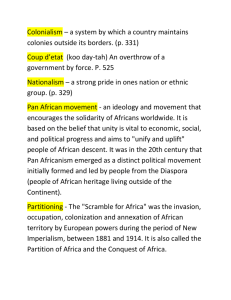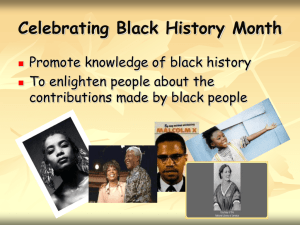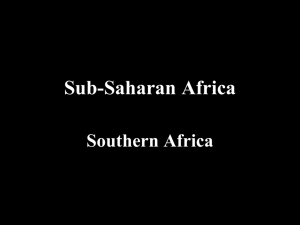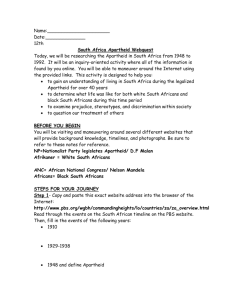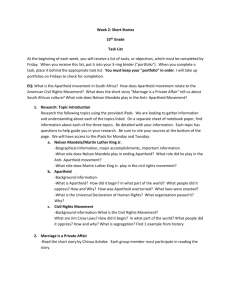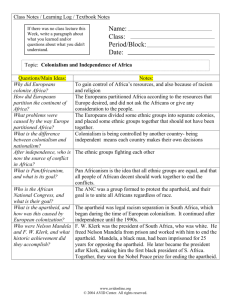South Africa PowerPoint
advertisement
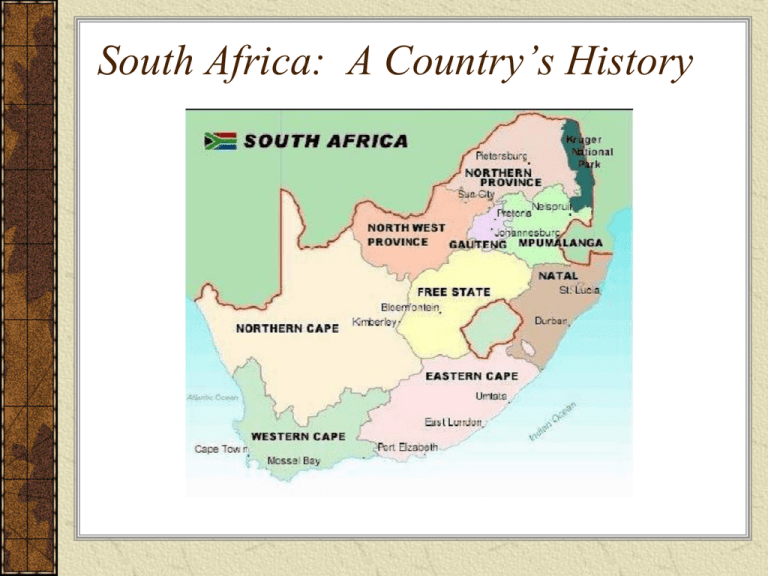
South Africa: A Country’s History Native Cultures of South Africa Zulu Tribe - The Zulu are the largest ethnic group in South Africa. They are well known for their beautiful brightly colored beads and baskets as well as other small carvings. They are also the most feared group because of their long history of deadly and fearsome warfare. (SPARTA, ASSYRIA) San - The 'Bushmen' are the oldest inhabitants of southern Africa, where they have lived for at least 20,000 years. Their home is in the vast expanse of the Kalahari desert. April 27, 1994 South African’s of all races will go to the polls in the first FREE and DEMOCRATIC elections in the nation’s history! On April 27,1994, Nelson Mandela became South Africa’s FIRST black president! Until this day, three out of four black South Africans had never been allowed to vote. WHY? APARTHEID A governmental policy of racial segregation. Apartheid : Separateness How did it all begin? Early Inhabitants of South Africa The Khoikhoi speaking people lived in the southern coastal region of South Africa, the San, or bushmen, in the desert region, and Bantu speaker (farmers, hunters, and herdsmen) in the east . And Then … In 1488, the Portuguese were the first Europeans to round the Cape of Good Hope, sailing for India. However, the first European settlement was not established until . . . . . . April 6, 1652 After the British decided against establishing a colony at the Cape of Good Hope, the Dutch, commissioned by the Dutch-East India Company, established Cape Town under the lead of Jan van Riebeeck. Accompanied by 82 men and 8 women, Riebeeck was instructed to establish a strong base to provide the Company’s ships with fresh food, water, and other provisions on the long journey from Europe to Asia. Riebeeck built the “Fort de Goede Hoop” and set up trade with the native Khoikhoi people and drove many from their homelands. Intermarriage 1700s – Slaves outnumbered the colony’s whites and intermarriage was common. • The children of such marriages become known as “Coloureds” being neither white or black. – Many Dutch settlers decided to Trek out on their own Expansion 1652: Cape Town established. Slaves from other parts of Africa and East Indies were brought in to clear farmland. 1659: Khoikhoi uprising failed. Natives retreated North. 1662: 250 Europeans, mostly Dutch and Germans settle in Cape Town. Become known as Boers, later Afrikaans. 1685: Interracial marriages between whites and local black slaves were banned. 1688: French Huguenots fleeing political persecution settle in Cape Town. Cape Town in modern times 1720-1770 Trek Boers expanded north and east looking for land for farming and grazing of cattle. They preferred free, unrestricted life to town law. They paid for their choice of lifestyle with constant conflict with the native “black” tribe population. Afrikaners (Boers) – Africa’s “white tribe” Dutch Trekkers developed their own culture and beliefs, including a strict form of Protestantism that portrayed them as a chosen people in a hostile word. – Protestantism (branch of Catholic church) The language they developed is a mixture of Dutch and African languages called Afrikaans. A Change in Politics Due to the French Revolution and the Napoleonic wars (1779-1806), the British gained control of the Dutch colony in Cape Town in 1795. By 1833, England had abolished the slave trade and the “Emancipation Act” demanded that white slave owners free their slaves promising a small compensation from the state for their loss. 1835: The “Great Trek” Feeling the British policy destroyed their political and social order, based on racial separation and that white dominance was “God’s own will,”10,000 Boers, or Voortrekkers, left Cape Town to escape British rule on a 1,000 mile migration inland, known as the “Great Trek.” A Series of Boer Struggles 1838: Boers defeat the Zulu nation in the Battle of Blood River in their fight to obtain land the Zulu tribe was occupying. 1843 : British take over Natal. 1852-1854: Boers travel further north and establish the Orange Free State and Transvaal as independent republics. 1870-1886: Diamonds deposits are discovered in Kimberley and gold deposits are discovered in Transvaal causing an influx of British immigrants and black Africans searching for work and fortune. 1880-1881: Anglo-Boer Wars More struggles 1899: Boer War erupted as a result of Afrikaaners upset over Continual British migration inland to the mining regions. 1899-1902: British established Afrikaner civilian camps where epidemics broke out and killed 26,000 prisoners. 1902: Boers surrendered to British rule 1910: British award independence to South Africa. They believed only white to be capable of self-government. Blacks were barred from voting and Afrikaans was made the official language. A Country Divided White South Africans made up only 21.5% of the total population and of these, an English-speaking minority dominated government and business in the cities. Most whites were Afrikaans-speaking Boers, mostly farmers and still bitter about the war The majority black population, 67%, included many different groups of people including Zulu and Xhosa of the Transkei region. Other groups were much smaller. By 1910, black Africans owned less than 10% of a country their ancestors completely controlled. 1913, the South African Parliament passed a Native Land Act that limited the blacks’ ownership of land even more. – Apartheid placed restrictions on how people could live. For example, black South Africans were made to live in tiny clusters of homes called townships. Other Ethnic Groups Coloureds: 9% of the population. Indian immigrants: 2.5% of the population. Both groups had varying rights in the Cape, but were not treated as equals by most whites The Native Homeland Act separated different African tribes into segregated areas. This act set aside 7.3% of the country’s land Aside as reservations and banded black Africans from buying land outside these areas. Road to Apartheid In 1912, the South African Native National Congress (later known as the ANC – 1923) was founded to unite black Africans and defend their interests. In 1913, the Afrikaaner Nationalist Party was established. Peaceful Protest 1912, a young Indian Lawyer living in Cape Town named Mohandas K. Gandhi became outraged after being thrown off the train for sitting in a “white’s only” seat. He organized a peaceful protest march, inspiring some black South Africans to form a civil rights organization. ANC African National Congress (ANC) was created to aide in the civil rights movement. In 1924, the Labour Party defeats the South African Party. Led by James Hertzog, South Africa became more independent of British control and favored the interests of whites, especially Afrikaners. Afrikaans is confirmed as an official language along with English. 1948: Apartheid becomes Law During the 1948 elections, the National Party introduced apartheid as part of their campaign. With the party’s victory, led by D.F. Malan, apartheid became the governing political policy until the early 1990’s. Many National Party members aligned with the Nazi party racist movement that had divided humanity into “master race” to dominate and an “inferior” race to be enslaved. Laws of Apartheid Apartheid is the rigid racial division between the governing white minority population and the non-white majority population. It is Afrikaan for “apartness” People were divided into three social groups White Black African or Bantu Coloured or people of mixed descent. Separate residential areas were established, with whites getting the best land. Blacks were put into areas called “homelands”. Black Africans were reduced to menial jobs (housekeeping, gardener, ect.) Pass Law required all ethnic groups, excluding whites, to carry passes to allow them to have Jobs and travel out of their Homelands. Racial segregation in all public institutions, transportation, and toilets. Bantu Education Act (1953) limited the quality of education young black Africans could receive. Homelands Covered 13% of South Africa’s land area for 75% of its population. Economic development was outlawed. The only work was in the white areas Blacks were forced to live apart from their families to work in the white areas where they had to carry Passes at all times. Pass Checks Checks were performed at random of any/all black Africans. Those without Pass were arrested and fined. If they couldn’t pay the fine, they were sent to work camps. Courtesy of www.unitedstreaming.com During the 1950’s The ANC declared that: “South Africa belongs to all who live in it, black and white,” and worked to abolish apartheid. A Suppression of Communism Act gave the government the power to imprison anyone accused of trying to make changes through “disturbance or disorder.” Nelson Mandela was elected national president of the Youth League. He planned a “Defiance Campaign” of marches and meetings for April 6, 1952 – just as Afrikaners celebrated the 300th anniversary of Dutch settlement. The Nationalist government cracked down with arrests and made apartheid laws harsher, but the campaign spread awareness abroad and the system was condemned by the United Nations. Mandela was arrested under the Communism Act. March 6,1960: Sharpeville Massacre A large crowd of Black South Africans assembled in front of the Sharpeville police station to protest the pass laws imposed by apartheid. After the Sharpeville Massacre, Thethe Pan-Africanist Congress (PAC),banned led by Robert Sobukwe, together government (exile) all with Nelson Mandela's African National Congress (ANC), organized the protest for the nation's blacks to join together to demonstrate black African political peacefully against apartheid. organization, including the ANC Rarely in South Africa before 1960 had so many black people demonstrated their defiance of thethe laws inPAC. any way. The police were and highly apprehensive, not knowing what to expect. Suddenly, tensions were released: the crowd pelted the policemen with stones, and the edgy policemen retaliated with gunfire. In the end, sixty-nine protesters were killed and one hundred and eighty were wounded (some shot while trying to flee) “Spear of the Nation” ANC created an armed resistance movement. It’s leader was Nelson Mandela. 1964, Mandela and the rest of the ANC leaders were arrested and convicted of sabotage and treason and sentenced to life imprisonment. During his 26 year imprisonment, his is work was carried on by his wife, Winnie, who herself spied on, kidnapped, and repeatedly was forced to move by police. Mandela went on the run after the ANC was banned. He was arrested in 1962, after secretly returning to South Africa, and was imprisoned for five years for organizing strikes. In 1963, Mandela was linked to a sabotage campaign in Rivonia near Johannesburg. He was sentenced for life. 1973, Mandela was offered a shorter sentence if he would support the bantustan program – he refused! In 1974, South Africa was banned from the United Nations General Assembly. 1976: Soweto When high-school students in Soweto started protesting for better education on June 16, 1976,police responded with teargas and live bullets. In the aftermath, the plan for schooling in Afrikaans was dropped and the UN banned sales of weapons to south Africa in 1977. Mid 1970’s – Mid 1980’s The government implemented a series of reforms that allowed black labor unions to organize and permitted some political activity by the opposition. The 1984 constitution opened parliament membership to Asians and Coloureds, but it continued to exclude black Africans, who made up 75% of the population. Many countries, including the United States, imposed economic sanctions of South Africa. More urban revolts erupted and, as outside pressure on south Africa intensified, the government’s apartheid policies began to unravel. Momentous Meetings In May 1988, the United Nations called for Mandela’s release without conditions. In July 1989, President Botha met with Mandela. Both men pledged a “support for peaceful developments.” Both resigned due to health reasons and was succeeded as president by F.W. de Klerk. Determined to break the “cycle of violence,” de Klerk Ordered the release of eight political prisoners. De Klerk and Mandela met in December. Mandela declared de Klerk to be “the most honest and serious white leader” he had ever met. On February 2, 1990, de Klerk announced the end of the bans on the ANC, the PAC, and over 30 other anti-apartheid organizations Free At Last! On February 11, 1990, after 27 years in prison, Nelson Mandela was released. “Today the majority of South Africans, black and white, recognize that apartheid has no future.” – Nelson Mandela Nobel Peace Prize Mandela and De Klerk both won the Nobel Peace Prize in 1993 for their efforts to end Apartheid. Accepting the award on December 10, 1993, Mandela declared: “We live in the hope that as she battles to remake herself, South Africa will be like a microcosm of the new world that is striving to be born.” On April 27, 1994, Nelson Mandela was elected the first black president if the first free election. “We are moving from an era of resistance, division, oppression, turmoil, and conflict and starting a New era of hope, reconciliation, and nation-building. I sincerely hope that the mere casting of a vote . . . will give hope to all South Africans.”- Nelson Mandela

